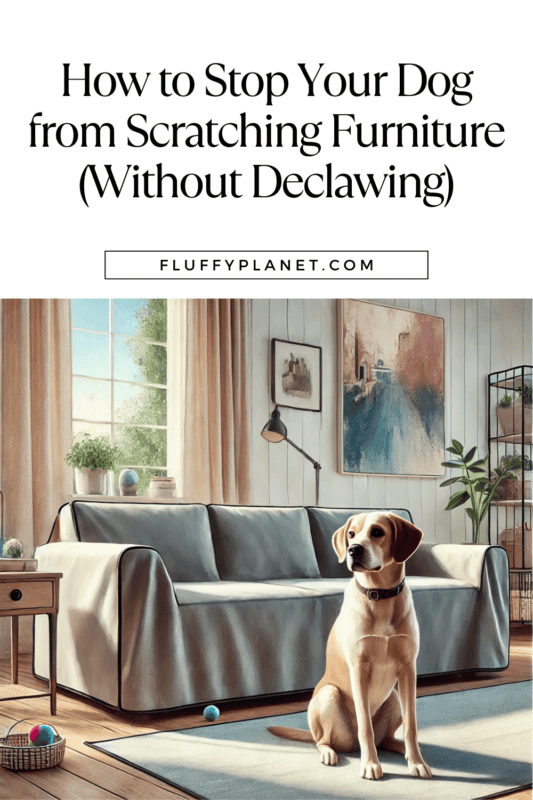If your dog loves using your sofa as a scratching post, don’t worry—you’re not alone. Dogs often scratch furniture due to boredom, anxiety, or marking territory. Instead of resorting to declawing, try these humane and effective solutions to keep your furniture safe while ensuring your dog’s well-being.
Top Tips to Remember
1. Understand Why Your Dog is Scratching
Dogs scratch furniture for a few key reasons:
- Boredom or excess energy: Without enough exercise or mental stimulation, dogs might scratch out of frustration.
- Anxiety or stress: Scratching can be a way for dogs to soothe themselves when they feel anxious.
- Marking territory: Dogs have scent glands in their paws, and scratching helps them leave their scent.
- Discomfort: Sometimes, dogs scratch if their paws are itchy or uncomfortable.
Understanding the cause will help you choose the right strategy to stop the behavior.
2. Offer Alternative Scratching Surfaces
Provide your dog with appropriate places to scratch, like scratch pads, carpet squares, or rug remnants. Place these items near areas your dog tends to scratch, such as next to the sofa. Make them more appealing by rubbing them with your dog’s favorite toy or using a dog-safe attractant spray. Reward your dog with treats and praise when they use these alternatives.
3. Keep Your Dog’s Nails Trimmed
Long nails can easily snag on fabric and cause scratches. Regular nail trims reduce the chance of damage to your furniture. Use dog-specific nail clippers or a grinder, and keep sessions positive with treats and praise. If your dog is nervous about nail trims, take it slow and try using a nail file for a gentler approach.

4. Use Slipcovers for Extra Protection
While training your dog, protect your furniture with slipcovers or blankets. Opt for machine-washable, durable fabrics that are easy to clean. This won’t stop the behavior but will help minimize the damage. You can also use a pet-safe deterrent spray with scents like citrus or bitter apple to make the furniture less appealing for scratching.
5. Check Your Dog’s Paw Health
Itchy or irritated paws can lead to scratching as your dog tries to find relief. Check your dog’s paws regularly for signs of dryness, cracking, or irritation, and use a paw balm to keep their pads moisturized. If allergies are causing the itchiness, consult your vet about possible solutions like hypoallergenic shampoo or dietary changes.
6. Provide Plenty of Exercise and Mental Stimulation
Dogs that are well-exercised and mentally stimulated are less likely to develop destructive habits like scratching furniture. Ensure your dog gets enough daily exercise through walks and playtime. Incorporate puzzle toys and interactive games to keep their minds engaged and prevent boredom.
7. Redirect Scratching Behavior Positively
When you see your dog scratching the furniture, calmly redirect them to an appropriate scratching surface or toy. Once they use the correct item, reward them with praise and a treat. Positive reinforcement teaches your dog that scratching in the right place brings good things, making them more likely to repeat the behavior.

8. Try Dog-Safe Deterrents
If your dog continues to scratch, use dog-safe deterrents like bitter sprays or double-sided tape. These products make the furniture less appealing for your dog. Bitter sprays have a taste dogs dislike, and sticky tape creates an unpleasant sensation on their paws. Always test any product on a small, hidden area first to ensure it doesn’t damage your furniture.
9. Address Anxiety Issues
If your dog scratches due to anxiety, particularly separation anxiety, it’s important to tackle the root cause. Provide comfort items like a favorite toy or a puzzle feeder when you leave. Gradually increase the time you spend away to help your dog adjust. Playing calming music or leaving the TV on can also create a soothing environment.
10. Stay Patient and Consistent
Stopping your dog from scratching furniture won’t happen overnight. Be patient and consistent with your approach, and remember that scratching is a natural behavior for dogs. Focus on redirecting it rather than trying to eliminate it completely. With persistence, you’ll see progress.
Final Thoughts
Scratching furniture can be a frustrating issue, but with the right strategies, you can effectively manage the behavior without resorting to declawing. By providing appropriate scratching surfaces, using deterrents, and meeting your dog’s physical and mental needs, you can protect your furniture while keeping your dog happy and healthy.



